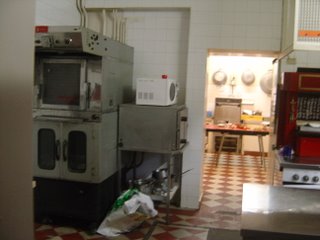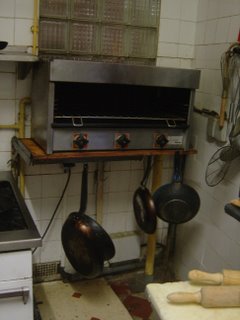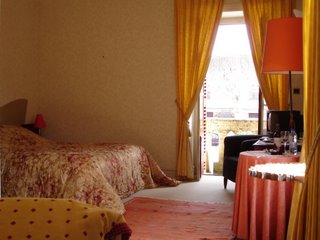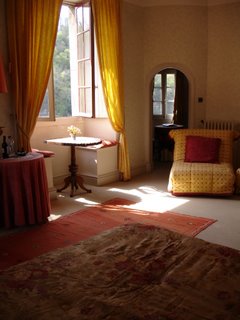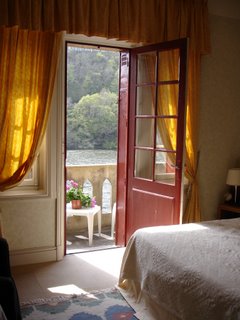I have had quite a few visitors to the Chateau as well as readers of the blog express their amazement that one very seldom sees an overweight person in this area. How is it possible to eat and drink so well and yet stay slim? Especially here in the Southwest where the farm markets, the fermes auberges, the restaurants and of course, the vinyards tempt us daily with their delicious produce, where everyone loves cooking and where cooking is a labour of love, where the very act of eating is a sensuous, lingering and pleasurable passtime............and -- where the Perigordien cuisine with all its magret and confit de canard, its salades de gesiers and nut oils, its pommes sarladaises and foie gras, are so rich and fatty and the eating of just one dish is a complete carbo-overload?
This is a question that has been asked through the ages -- and the definitive and final answer, I believe, can be found in the book that was published a while ago and took the world by storm :
Mireille Guiliano's "
French Women Don't Get Fat".

Interestingly, one of the first questions visitors to the Chateau ask me --
especially at the end of their first long leisurely meal!, is what it is that this French woman wrote in her book -- what exactly is the French secret for staying slim when eating is so much [part of the wonderful way of life in this part of the world?
Mireille Guiliano describes her book as the "ultimate non-diet book." There are no carb counts, and no fat grams listed in the various personal recipes she shares with readers in the book. Her basic advice is what I see all the French around me do: They eat only good food -- as in good quality, and they relax and savour every bite.
We all know that most "
diets" don't work for long term. Mireille says what we know, but somehow never really want to believe: "
There is no lasting glory in rapid weight loss. That's what diets offer: a fast (weeks, not months) round of misery for temporary results. If you believe you can shed pounds quickly by force of will and deprivation, you will in all likelihood not only regain the ones you lost, but add a few more besides." Part of the problem is that diets are boring.
And how can one possibly follow a boring diet whilst living in the Perigord?
The book does give pratical advice, such as
keeping a food journal,
to savour what you eat ---"
French women eat with all five senses", she says. "This allows them to actually eat less because they are actually paying attention to what they are tasting."
The other key factor, she says, is that French women don't eat until they are full. She believes that three bites of a dish are all you really need to enjoy, and she really applies that rule personally when it comes to her -- and my! weakness: pastries;
to make good eating habits part of your life style --- "proper recasting, resetting your body's dials, is a three-month affair. The key is to make it a pleasant three months, not a sentence in Bastille";
to make your meals part of ritual--- "
French women love to shop and prepare food. They love to talk about what they have bought and made. It's a deeply natural love, but one that is erased in many other cultures. Most French women learn it from their mothers, some from their fathers. But if your parents aren't French, you can still learn it yourself." She says that you should go to the market two to three times a week and buy only what you need. None of this twice-a-month supermarket grocery shopping -- in no time, you will find yourself doing it automatically.
drink lots of water---French women understand that drinking water is a powerful way of controlling one's weight -virtually without sacrifice;
choose quality over quantity when buying, preparing and eating food;
and -- "A final trick of variety: Since the pleasure of most foods is in the first few bites, eat one thing on your plate at a time, at least at the start of the meal when you can concentrate and enjoy the full flavors. The mouthful of melange (blend of foods) defeats the purpose of variety";
portion control: Eating good food is great, but do you really need big portions of it? No. You won't notice that you're eating less, but your body will.
And on a related note, if you are craving chocolate, have one bar of good quality chocolate and have one bite, that's all you really need to satisfy your craving. Is there anything in there that you did not already know? Of course not! BUT -- the secret is to follow these basic principles...........When it comes to drinking wine, Mireille gives the typical French -- and common sense answer, once again: Cut out the cocktails -- cocktails have far more calories than wine. It is best to have wine with food -- that is how it is meant to be consumed.
And then, the last bit of advice Mireille gives us in her book, is to get exercise and she recommends to do what French women do -- they walk!  Two Perigordien RecipesConfit de Canard
Two Perigordien RecipesConfit de Canard (Preserved Duck) (Serves 4)
Like any long-term relationship, preserved dishes need time to adapt and live in harmony. This recipe takes one month to preserve the lemons, at least one week to preserve the duck.
Confit is a marriage of flavour between the duck meat and the fat -- the duck slowly tenderized in a warm bath of silky fat while the fat becomes infused with the rich, gamy flavor of the dark duck meat. The best results in making confit is by using duck leg joints with the thigh attached and I like to crisp the skin of the duck just before serving and pair the confit with simple green salad and the zesty citrus flavor of preserved lemons. 4 duck legs with thighs attached
3 bay leaves
3 sprigs fresh thyme
3 sprigs fresh rosemary
6 garlic cloves, crushed
course sea salt and freshly ground black pepper
6 cups duck fat or lard
Liberally coat the duck legs with salt.
Place the duck legs in a glass baking dish.
Add the bay leaves, thyme, rosemary, garlic.
Liberally sprinkle the duck with the black pepper.
Cover the dish with plastic film and refrigerate the duck for 2 days.
Remove the duck from the refrigerator and lightly brush off the salt.
Heat the fat in a deep, heavy stockpot over low heat.
Place the duck legs in the fat. The fat should completely cover the duck.
Add the bay leaves, thyme, rosemary and garlic to the pot.
Bring the fat to a very gentle simmer, but do not allow it to boil.
Cook the duck uncovered in the fat for 3 hours or until it appears very tender and just pulls away from the bone.
When the duck is done, place the pieces in an earthenware crock large enough to hold all four legs. Pour the fat over the duck. Cover the crock and refrigerate the
confit.
I prefer to let the duck sleep in this state for at least one week before using. __________________________________________Pommes de terre a la sarladaiseThese potatoes with confit de canard or confit d'oie are a marriage made in heaven.800gms waxy potatoes (Charlotte, for example)
One-and-a-half tablespoons duck or goose fat
2 cloves garlic - finely chopped or crushed
1 tablespoon flat-leaf parsley, finely chopped
salt and pepper
Peel and wash the potatoes.
Cut into slices of about 3mm. Dry these slices on kitchen paper or a clean tea cloth.
Melt the fat in a wide non-stick frying pan. Cook on medium heat for 15 minutes, shaking the pan frequently to ensure that both sides of each slice are nicely browned. Season with salt and pepper.
Mix together the crushed garlic and the chopped parsley. Add to the potatoes. Now, cover the pan and leave the flavours to mingle over low heat, shaking the pan frequently to make sure that the garlic and parsley are evenly distributed.
__________________________________________Click on Link:
Chateau Lalinde : The perfect venue for your event
TAGS: Events Rent a chateau France
Chateau
Perigord Food Holidays in France Recipes












